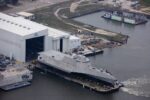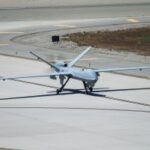Norway has selected the UK’s Type 26 Global Combat Ship as its next-generation frigate, announcing a strategic partnership with London to procure at least five ships in a deal valued at £10 billion—the largest defense procurement in Norway’s history. Deliveries are due to start in 2030, with Norwegian and British frigates intended to be “as identical as possible,” enabling joint training, maintenance, and even potential crew exchanges. The agreement includes industrial cooperation matching the full value of the acquisition and will sustain ~4,000 UK jobs, more than half in Scotland’s BAE yards.
What was actually decided?
This is more than a purchase and less than a signed shipbuilding contract—for now. Oslo named the UK its strategic partner for frigates and selected the Type 26. The two governments will now finalize an intergovernmental framework, then negotiate detailed ship contracts with BAE Systems (price curve, batches, delivery cadence). That nuance matters: schedules, workshare specifics, and long-lead items move only after the G2G framework is inked.
Key official points from Norway and the UK:
Scope & value: At least five Type 26 frigates; package publicly framed at ~£10 billion.
Timeline: Deliveries due to start in 2030.
Configuration: Norwegian and Royal Navy ships “as identical as possible” (tech specs aligned) to cut cost and maximize interoperability; partnership includes shared maintenance, training, and the option to swap crews. Regjeringen.no
Industrial policy: UK pledges extensive cooperation with Norwegian industry equal to the acquisition’s total value; in Britain, the program supports ~4,000 jobs across ~400 companies, including ~2,000 in BAE’s Glasgow yards.
Why Type 26—and why now?
The threat picture: the High North is noisy again
The GIUK gap and Barents/Norwegian Seas are once more crowded with Russian SSNs/SSBNs and cruise-missile shooters. Norway’s fleet must hold the line on ASW while protecting offshore energy and subsea infrastructure. A dedicated quiet ASW frigate is the rational choice.
Platform logic: purpose-built for ASW
Type 26 brings low-acoustic-signature propulsion, towed-array sonar, and a hull optimized for long-endurance submarine tracking—a combination central to modern Atlantic warfare. Public reporting notes quiet propulsion, towed array, and extreme-weather suitability as core features highlighted to Norway.
Interoperability & scale
Operating near-identical ships with the Royal Navy compounds training, spares, and tactics. London says the partnership yields a combined fleet of 13 ASW frigates (8 RN + ≥5 Norway) that will patrol and hunt together on NATO’s northern flank.
What the ship likely carries (and what’s still open)
Public sources outline the baseline Type 26 combat system fit in Royal Navy service:
Air defense: Sea Ceptor (CAMM) for local-area protection.
Sensors: BAE’s Artisan 3D radar and an advanced sonar suite (including towed array).
Strike flexibility: Mk 41 VLS (strike-length) allows future land-attack/ASROC options; a 127 mm (5-inch) gun covers surface/NSFS tasks.
Two key caveats for Norway:
Exact weapon fits aren’t announced. Oslo and London intend near-identical specs, but final Norwegian selections (e.g., exact radar variant, EW suite, VLS loadouts) will be set in the BAE contract. The framework, not the line-item load, is what’s public today.
Helicopters: Norway confirms the frigates will embark ASW helicopters, but the type for these ships isn’t formally named in the press release. Norway has separately ordered six MH-60R Seahawks (2025–27 delivery) to rebuild maritime aviation after the NH90 cancellation; whether all Norwegian Type 26s standardize on MH-60R remains to be seen.
Analyst note: Given Norway’s existing Naval Strike Missile (NSM) ecosystem, integration of canister NSM for surface strike is a reasonable expectation, but it has not been officially declared for the Type 26 package. Treat it as likely, not confirmed.
Industrial and political ramifications
UK shipbuilding cadence: The export win keeps Glasgow lines hot alongside the RN’s own eight-ship program, stabilizing supplier workloads through the 2030s. London claims ~4,000 jobs safeguarded—headline politics amid a “defense for growth” narrative.
Norwegian offsets: Oslo secured a value-for-value cooperation pledge; expect MRO, systems support, composites and structures, and training/simulation work to flow to Norwegian industry. Details follow after the framework agreement.
Europe’s ASW center of gravity: With the UK, Norway, plus Type 26 derivatives in Australia and Canada, an Anglo-centric ASW community is forming around similar hulls/tactics—useful for GIUK and North Atlantic tasking.
What Norway is replacing—and the lessons learned
The Royal Norwegian Navy has operated four Fridtjof Nansen-class frigates since losing KNM Helge Ingstad in 2018 after a collision and salvage failure—a national trauma that sharpened debates over availability and mass. The political climate shifted post-2022; consensus hardened around paying for credible high-end naval capacity. The Type 26 choice reflects that turn.
Timeline: what to watch between now and 2030
G2G framework signed (weeks): locks partnership architecture and governance.
Ship contract(s) with BAE (months): defines number in first batch, price curve, milestones, workshare & industrial projects.
Long-lead procurement (2026–27): propulsion/electrics, steel, combat-system majors.
Build and trials (late-2020s): Glasgow block build, harbor & sea trials; first delivery from 2030.
Tactics & training alignment (ongoing): joint RN-RNoN ASW doctrine, simulator federation, personnel exchanges.
Capability analysis: strengths and trade-offs
Where Type 26 shines
ASW first: Ultra-quiet drive, towed array, and long endurance make it a true sub-hunter, not a generalist with a sonar.
Growth room: Mk 41 gives a path to deeper strike/ASROC options; modular mission bays ease UUV/USV adoption for seabed and MCM tasks.
Allied mass: Identical RN/RNoN hulls compress training and interchangeability—useful when tasking surges in the Arctic.
What to keep an eye on
Schedule discipline: The Norwegian MoD still must drive contracting and long-lead on a tight clock to make 2030. Any slip in RN yards or supplier bottlenecks will ripple.
Cost realism: £10 billion is the political headline; real unit cost depends on weapons, sensors, spares, training, and Norway-specific mods.
AAW depth: Type 26’s local-area air defense (Sea Ceptor) is strong, but it is not a dedicated AAW destroyer. If Oslo wants extended-range AAW, that drives VLS loadouts and sensor decisions later.
Helo & UxS integration: Locking MH-60R tactics and UUV/USV concepts early will decide how much ASW advantage Norway actually gets on day one.
How this reshapes NATO’s northern maritime posture
London’s framing is explicit: a combined RN-RNoN Type 26 flotilla will patrol Northern European waters to hunt submarines and safeguard undersea infrastructure—cables, pipelines, energy platforms. Expect tighter standing NATO maritime group rotations and more carrier-strike group pairings in the North Atlantic and Norwegian Sea.









